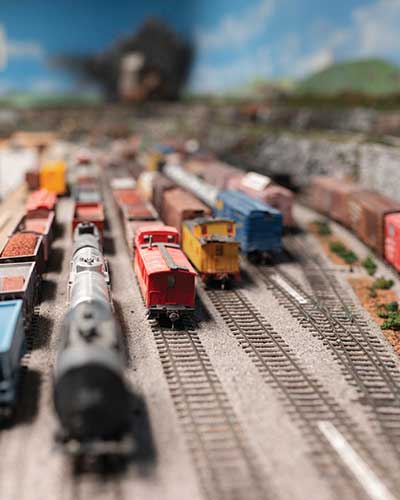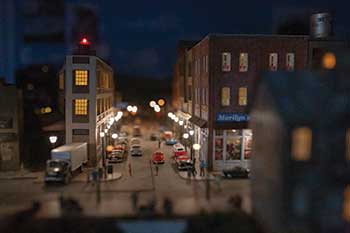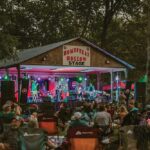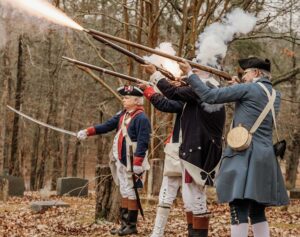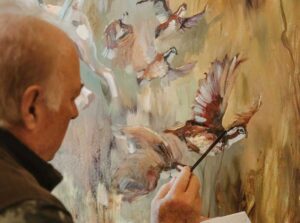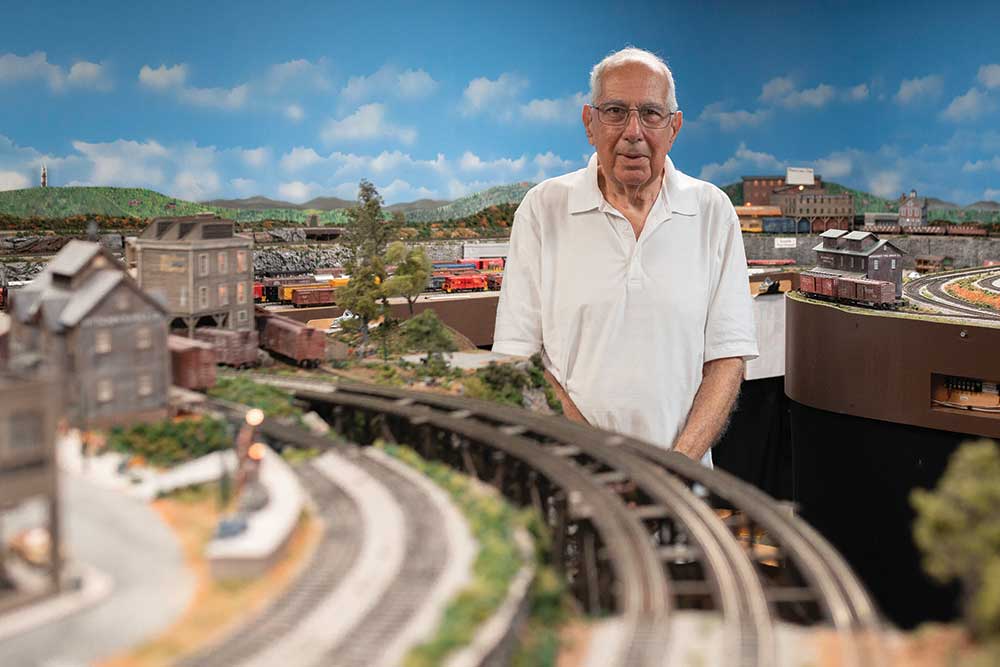
Architect designs, creates, builds model trains
Story by Scottie Vickery
Photos by Mandy Baughn
It’s been said that much about your childhood – your neighborhood, the house you grew up in, or the size of your backyard – often seems smaller when viewed through adult eyes.
For Malcolm Sokol, everything about Birmingham seems downright tiny. That’s because the retired architect and model railroad enthusiast has spent years recreating his version of the city’s Industrial District, all in miniature.
He’s built his own small-scale 1952 versions of Ensley, Pratt City, North Birmingham, Elyton, Red Mountain and other areas, along with the railroads that connect them. There are restaurants, stores, warehouses, iron ore mines, steel mills, a rail yard, Sloss Furnaces and a railroad trestle. And he’s built it all within a room that measures 13 x 19 feet.
“A genuine model railroader tries to make everything as realistic as possible,” said Sokol, who now lives in Cropwell on Logan Martin Lake. There’s no doubt that Sokol, who estimates he’s spent more than 12,000 hours over the past eight years or so on his hobby, is the real deal. He’s got an assortment of regional and national awards for his designs to prove it.
“You can make a career out of a hobby, but when you love it so much it’s not like going to work,” he said. “You don’t put any value on your time with a hobby unless you plan to sell something, and I would never sell this.”
In addition to the time and money he’s spent creating his HO scale model railroad layout, Sokol has an emotional and sentimental investment, as well. It brings back memories of his childhood.
“I grew up in Fountain Heights, and when I was a kid, we used to walk down to the railroad tracks, which were about two blocks away,” he said. “We loved to watch the switching (of rails and cars) at all of the industries.”
Getting on track
Sokol, a member of the Wrecking Crew Model Railroad Club in Birmingham, got his first model railroad set when he was 8 or 9. “My father gave me and my younger brother, Howard, a Lionel O Guage railroad set,” he said. “We played with that thing until we wore it out.”
Some neighborhood friends had sets, as well, and they would put them together and play for hours. “That was my introduction to model railroading,” he said.
His interest was renewed not long after he and his wife, Marilyn, had their first child. They went to a model railroad show, where Sokol bought a set. “I said I was buying it for my son, but he was only a year and a half old at the time,” he said with a laugh.
Today, Sokol loves sharing his hobby with their three children and their spouses, along with their seven grandchildren and four great-grandchildren. The Sokols’ home may be the only house on the lake where guests want to spend as much time inside as they do by the water.
“They love to run trains,” he said of his family and friends. “Everyone who comes here says, ‘Let me see what you’ve done on the trains’ They love to see the progress.”
There’s always something new to see in his train room, which used to be part of his garage. When Sokol got serious about his hobby, he finished the area, adding a ceiling and walls. He put the Masonite backdrop on three walls of the room, and he and his grandson, Garrett, used stencils to paint clouds and mountains. He later installed additional mountains he’d painted on panels of Masonite in the foreground, creating a multi-dimensional background.
The first two years were dedicated to building the frame and foundation for the layout and for laying the track. Using historical rail maps for Birmingham as a guide, Sokol added some of the industrial buildings that were built alongside the city’s tracks. His layout includes Loveman’s Warehouse, Pittsburgh Plate Glass Co. and the A&P Warehouse and Distribution Center.
First National Bank and Pete’s Famous Hot Dogs are represented in the layout, while some of the stores, such as Marilyn’s Knit Shop, were named for family members. Businesses in the Ensley section of the layout include Ideal Furniture, The Bank of Ensley and Gilmer Drugs. Sokol recently added Phase 2 of his railroad, which extends into an adjacent room measuring 13 x 6 feet.
Details matter
Sokol said the skills he honed during his architectural career, which spanned more than 30 years before he retired as CEO of Evan Terry Associates in 1998, has come in handy. “It definitely helps,” he said. “I have the design ability and the construction knowledge.”
Being his own client has allowed him the freedom to build everything just the way he wants. Although much of the layout was based on historical renderings, he took some artistic liberties, as well. “When you own a model railroad, you’re the owner and designer and you can make all the decisions,” he said. “When you’re playing all the roles, it’s easier.”
Sokol’s attention to detail is amazing. Although many model railroaders buy pre-made tracks, he bought the rails and used a band saw to cut 35,000 tiny wooden ties, which he attached with miniature metal spikes. “It’s all hand-laid, just like the real railroad does,” he said.
Most of his buildings are scratch built, meaning he designed, cut, assembled and painted them by hand, rather than using a kit. A watercolor artist, Sokol’s painting skills add an additional level of realism to his cities and buildings that takes time to create. He spent six months, for example, building and painting the railroad trestle, which is modeled after the L&N Cane Creek Trestle #10 in Brookwood.
Sokol’s favorite building, which happens to be the first one he made, is one he named the Starry Eye Mattress Company. In addition to the architectural details, there’s a dumpster, trashcans, barrels, bales of cotton and small wooden pallets where workers can be seen stacking mattresses.
The design won two regional awards, including Best in Show, and was displayed one year at the National Model Railroad Association’s convention. “One of the kit manufacturers from Maine found me and said, ‘I want to build a kit out of this model,’” he said.
Sokol gave him permission and the kit maker changed the name of the business to Sokol’s Mattress & Furniture Company as a nod to the creator. The original limited run of 500 kits, priced at $160 a kit, sold out in the first year. Some are currently being re-sold on eBay for more than $200.
While many of the railroad accessories can be purchased, Sokol spends hours creating his own. Model railroad switches, which allow trains to be guided from one track to another, can be purchased for about $30. “I built my own switches for $2 worth of materials,” he said. “I probably saved about $3,000 right there.”
Although saving costs in what can be an expensive hobby is a motivator, part of the fun for Sokol is figuring out how to make his own buildings and structures. The blast furnace on his Sloss Furnaces layout, for example, was made from a wiffle ball bat. “I needed something that was rounded and tapered, so I just cut off each end of the bat,” he said.
He made his lampposts, which are only a few inches tall, out of three different thicknesses of tubing. All of the lighting on the layout, whether on lampposts or in buildings, is fiber optics, he said.
Much of the materials he uses comes from his own backyard. He gets scoops of dirt, bakes it to kill any bugs, sifts it, and attaches it to the ground of the layout with white glue. He makes tree trunks from azalea limbs, drilling holes in the trunks to add smaller branches. Sokol uses hairspray to make clumps of painted ground foam that he uses for the foliage on trees and bushes. “I’ve given workshops on making trees,” he said.
Sights and sound
The electronics that are part of the railroad layout are as impressive as the designs. One of the most popular features is a lightning and rainstorm over one of Sokol’s buildings on his miniature Red Mountain. The soundtrack features thunder and wind, slamming screen doors, barking dogs and other lifelike noises.
The evolution of the technology used to operate the trains makes everything more realistic, Sokol said. “It used to be that every train on the track would go at the same speed and in the same direction,” he said. Now, there’s a computer chip in each locomotive, and model railroad engineers can run trains backward, forward and at different speeds, all on the same track. They can also control sound effects, such as bells, horns and brakes.
Although Sokol completed most of the work on his layout himself, he had several model railroader friends who shared their expertise. Steve Singer helped lay the ties and build the benchwork, which is the foundation for the trains and scenery. Winston Greaves helped with the electronics, and Dave Whikehart helped build the structures. Sokol said he figures everything is about 80 percent complete, but don’t hold him to it.
“A lot of people will ask model railroaders when they are going to be finished, and the answer is they will never be finished,” he said. “There is always more detail to add, and some will build a scene, decide they don’t like it and start over with a new one.”
Although the trains have brought Sokol much joy, they are not his only hobby. He and his wife love to travel – they’ve been to Australia and New Zealand this year and often spend a month or more in a city so they can live like the locals. Although he loves the adventure, he’s always glad to get back to his model railroad.
For the past 15 years or so, he and the other members of the Wrecking Crew club have built locomotive exhibits for the McWane Science Center, which are displayed during the holidays. Aside from the fun of helping to create the layouts, he enjoys watching the children and families enjoy them.
“It’s very rewarding,” he said. “This is a great hobby.”











